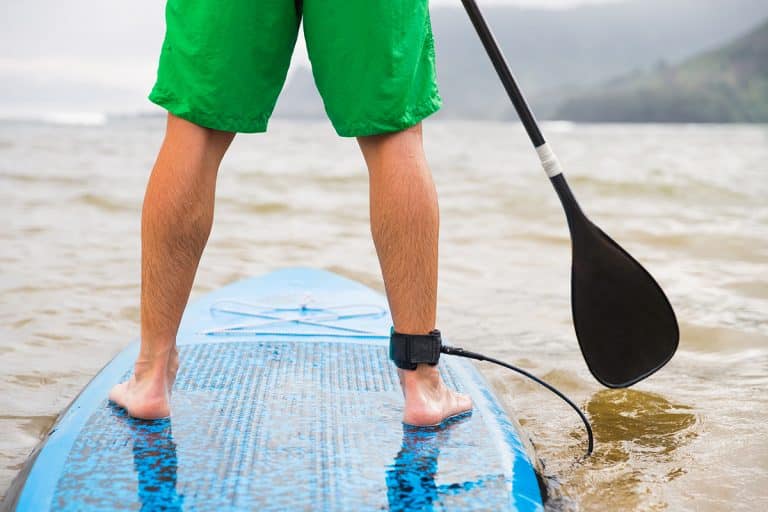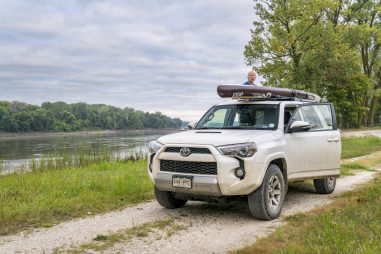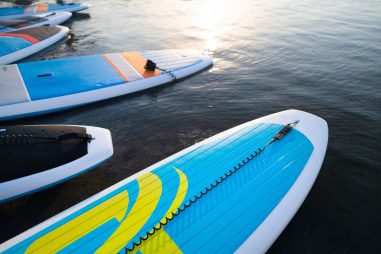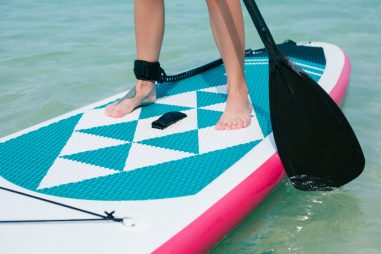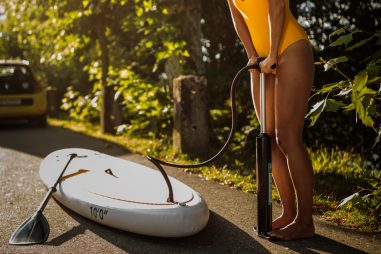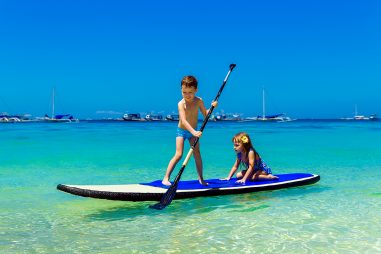Stand up paddle boarding has to be one of the most minimalist water sports ever. The basic gears would only include the paddle board, a paddle, and, sometimes, a personal flotation device or PFD. And since you do not need much to start paddling, you might as well get the best gears around. Read on to know how to properly hold a paddle, what to consider when choosing a paddle, what the best paddle brands are, how to make your own wooden paddle, and how much a paddle cost.
How Do You Hold a Paddle Board Paddle?
One of the first things that you should learn in stand up paddle boarding is how to hold your paddle. When you properly hold your paddle, it can help you move and control your board the right way, help you with your stance, and power your strokes. It will also allow you to paddle faster, further, and above all, more comfortably.
Here are some tips on how to get the proper positioning of your hands on the paddle:
- With one hand, grab the T-grip (also referred to as the T bar) located at the end of the paddle. Use your other hand to comfortably grip the shaft of the paddle.
- Raise the paddle above your head. Make sure that the shaft is resting on your head and the paddle is in line with your shoulders.
- Keep your hold on the T-grip, then position your other hand on the shaft while making sure that both your arms are at a 90-degree angle at the elbows.
- Remember the placements of your hands (on the T-grip and the shaft) because this is exactly where you want your hands to be when you are paddling.
- The hand holding the shaft should be at least a shoulder-width apart from the hand holding the T-grip.
- Remember to keep a comfortable grip on the paddle. If your hands are too close together then your strokes would lose power.
Another great tip to remember is that the hand that grips the paddle shaft should match the side that you are paddling on. This means that if you are paddling on the right side of your stand up paddle board, then you should be gripping the paddle with your right hand.
Which Way Should a Paddle Board Paddle Face?
This is one of the most fundamental lessons to be touched up in your stand up paddle boarding lesson. Make sure that the blade is angled forward and away from you. If the paddle is facing the wrong way or if you hold your paddle backward (which is incorrect), you would have a hard time paddling because the design work of the paddle is working against you.
You can check if your paddle is facing the wrong way while standing on your board. All you have to do is to hold your paddle perfectly vertical and, in a way that you can see the blade. The paddle is facing the right way if the angle is tilted away from your body.
Do Paddle Board Paddles Float or Sink?
While most paddle board paddles float, there are some that sink depending on the material that they are made of. Buoyancy is also the science behind paddles being able to float, much like that of the paddle board. The foam inside the shaft provides buoyancy on the paddle.
However, some paddles can still sink especially if they are made of metal, more specifically aluminum. Although the padding in the shaft helps to keep it afloat, you have to be quick to get it back to safety when you lose your hold on it.
Another factor that keeps the paddle afloat is how air tight the paddle shaft is. There are paddles that consist of two or three parts or pieces. If the connections between these pieces are not air tight or even tight enough, then there is a bigger possibility of the water coming. The water will make the paddle less buoyant and possibly sink to the bottom.
Before deciding on a paddle, it is always better to do a float or sink test on your paddle.
How Do You Pick a Paddle Board Paddle?
There are several factors to consider when choosing a paddle board paddle. Keep this in mind if you are on the lookout for the best paddle for you.
- Length: On the one hand, getting a paddle that is way too long is a lot more difficult to carry and use. On the other hand, using a shorter paddle means that you would have to lean over and hunch in an uncomfortable position. A paddle’s length is something important to consider because choosing the right length will help you maintain proper form and efficiency. It is also important to consider your riding style. Aside from the riding style, you should also decide if you want a fixed-length paddle or an adjustable-length paddle.
- Fixed-length paddle: Like what the name suggests, fixed-length paddles are non-adjustable. Some paddles prefer this kind of paddle because they are lighter and stiffer. If you are getting a fixed-length paddle, make sure that it is the appropriate length for your height.
- Adjustable-length paddle: Adjustable-length paddles are a lot more versatile than fixed-length paddles. You can personally adjust it, so it fits your height. Aside from that, you can also easily change the lengths of the paddle so that it can be used for touring, racing, surfing, or relaxed paddling. Adjustable-length paddles cater to more paddlers of varying height and riding styles.
- Material: Stand up paddle board paddles are made of different materials. The materials are often used to determine the weight, stiffness, and price of a paddle.
- Wood: While wooden paddles can be very beautiful, they also come with a hefty price tag. Aside from that, these paddles can be heavier than paddles made of other materials.
- Plastic: Paddles made of plastic are often the cheapest option in the market. Some brands combine plastic with fiberglass. Sometimes the blades and grips are made of plastic while the shaft is made with aluminum.
- Aluminum: Aluminum is often used in the shaft of paddles. This material often makes lighter paddles. During construction, shafts made with aluminum are often partnered with blades made of plastic. Aluminum paddles are recommended for beginners.
- Fiberglass: Consider getting a paddle made of fiberglass if you want a light and stiff paddle. The stiffness of the fiberglass paddles helps power your strokes. These paddles, however, are a lot more expensive than those made of plastic and aluminum but are cheaper than carbon fiber paddles.
- Carbon fiber: Paddles made of carbon fiber are often the most expensive ones in the market, but for good reason—they make the lightest and stiffest paddles. This is a great paddle to have especially if you like long-distance paddling. The stiffness of carbon fiber helps a lot in powering your strokes. Due to the cost of this material, they are often combined with fiberglass when being used for paddle constructions.
- Blade Size: The blade is the part on the other end of the paddle that you dip into the water. Its size affects the performance of the paddle. While there are no strict rules on what blade size to get, paddlers often develop their preference depending on their riding style and body type. Paddlers of small to medium body type weighing less than 150 pounds or approximately 68 kilograms should get a blade that is 80 to 90 square inches. Meanwhile, paddlers weighing 150 to 200 pounds (approximately 68 to 91 kilograms) are considered to be of medium to large body type and should get a blade that is 90 to 100 square inches. Lastly, paddlers weighing more than 200 pounds or those with large to extra-large body type and should get a blade that is 100 to 120 square inches in length. Another thing you need to remember is that small blades are more efficient while large blades are more powerful. Large blades allow for more powerful strokes while small blades use less effort.
- Blade shape: There are two kinds of blade shape, and it is important to consider these because they affect the power of the blade. While there are no strict rules about the shape that you should get, as you continue on with your stand up paddle boarding practice, you would eventually develop a preference.
- Rectangular: Rectangular-shaped blades are designed to be narrower at the bottom. Due to this design, these blades allow for gentler strokes and are, thus less taxing on your body. They also make it possible to use a higher cadence stroke.
- Tear-drop: This blade is designed to have a wider bottom. This allows for a more powerful stroke because lot of surface area is pushing the water. They also make it possible to use a slower cadence stroke. This shape is great for SUP surfing and paddling.
- Blade offset: The offset pertains to the degree that the blade angles forward, and it is an important factor to consider because the size of that angle affects the power of your strokes. The angle should be approximately 7 degrees if you will be using your paddle for SUP surfing. Meanwhile, a blade that is approximately 10 degrees is great for all-around paddling. Lastly, a blade that is approximately 12 degrees is great for stand up paddle racing.
- Weight of the paddle: Remember that lighter paddles make it possible to make easier strokes. You also don’t need to exert that much energy when paddling which means that you can go on for longer and further.
What Is the Best Paddle Board Paddle?
Now that you know what factors to consider when looking for a paddle that is perfect for you, here are some of the top paddle brands on the market today.
- Abahub 3-Piece Adjustable Paddle: This adjustable-length paddle is designed with a carbon shaft which makes it lightweight and ensures that it floats. It is also stiff and flexible which allows for better paddling without the fear of breaking when used with extremely powerful strokes. This paddle can be adjusted from 67 to 86 inches or 170 to 218 centimeters and is great for paddlers taller than 5 feet.
- BPS Adjustable 2-Piece Paddle: Made with a combination of carbon fiber and fiberglass, this adjustable-length paddle can extend from 1,800 millimeters to 2,130 millimeters or 70.86 to 83.85 inches. The parts of this paddle can be adjusted easily, and the manufacturers ensure that when put the parts are put together, the whole paddle will float.
- Isle Surf and SUP 2-Piece Paddle: This adjustable-length paddle can be extended from 67 to 83 inches and is great for all skill levels. The 2 parts of the paddle make it portable and easy to be stored. Made with a carbon fiber shaft, this paddle is sure to be lightweight. It is also made with a stiff shaft which allows for efficient and powerful strokes. The blade surface, made with nylon, measures 92.85 square inches. This paddle board is very convenient and easy to store.
- Airhead: Made with aluminum, plastic, and fiberglass, this adjustable-length paddle weighs 2.75 pounds. It can also extend from 63 inches up to 86 inches. The Airhead paddle has a lightweight oval shaft that keeps your arm from fatigue. The blade is also reinforced with fiberglass with means that is extremely lightweight and durable.
- Aqua-bound Lyric: This adjustable-length paddle comes in two sizes. The first one is small that can be extended from 64 to 74 inches. The other size is large, and this paddle can be extended from 70 to 80 inches. The Aqua-bound lyric paddle weighs 1 pound and 7.5 ounces. It is also designed with a combination of a polymer blade and a shaft made of carbon fiber. The blade offset is 10 degrees, and it is also has a smaller blade.
Can You Use a Kayak Paddle for a Paddle Board?
There is no rule prohibiting the use of a kayak paddle on a paddle board, but it is NOT recommended. For one, there is no T-grip or T-bar for your hand to hold on to because both ends of a kayak paddle have blades. Another thing is that the kayak paddle may not be the perfect height for you to be able to make efficient and powerful strokes. If you try to use a kayak paddle while touring, you might have a hard time traveling far.
But that doesn’t mean that you can’t use your paddle board to kayak. There are kayak seats that you can mount on your paddle board. Another trick is to get your adjustable paddle board, take out the T-grip part and replace it with another paddle. Voila! Now you have a kayak paddle that you can use on your stand up paddle board.
How Do You Make a Wooden Paddle Board Paddle?
Stand up paddle board paddles can be hard on the wallet, especially wooden ones. But if you are handy enough, you have knowledge on woodwork, and you have all the materials then you can DIY your own paddle.
Here are the materials that you would need to build your wooden paddle:
- One-fourth inch of Closet Pole that is equivalent to your height
- 2-inch #10 stainless steel wood screw
- Approximately 16 inches by 24 inches piece of finish plywood
- A small can of marine grade varnish
- One-fourth inch hole saw
- 2-inch chip brushes (about 6 pieces or so)
- 2-inch foam brushes (about pieces 3 to 4)
- Bondo squeegee
- 220 grit sandpaper
- 60 grit sandpaper
- Acetone
- Masking tape
- Marine epoxy
- Plastic mixing cups (about 8 ounces)
- 6 ounces fiberglass cloth (about 4 square feet)
- Resin thickener/filler
- Disposable gloves
Now that you finished buying these items in a lumber or hardware store, it’s time to look into your shed and find these tools:
- Drill press
- Jigsaw (either bandsaw or coping saw)
- Table saw
- Mini-grinder (preferable with sanding disk)
- Orbital sander
Do you have everything that you need? If the answer is yes, then we can proceed to the best part—the construction.
- Make the template: Find your desired paddle blade template online. Take into consideration your height and your riding style. Now that you found a template, print the actual size on three pages. Make sure that the template is aligned in the sheets and tape them together. Before cutting out the template, recheck if it is your desired blade size.
- Cut the shaft taper: You would need a taper jig to help you in this step. Mark two ends of your shaft depending on your height. Make a diagonal cut so that you have a 10-degree angle. You will need to stand on the right side of the table saw, keep the dowel down, and align the fence so that the blade just clears the wide end of your jig. You can either use a tail-off table or ask a friend to help you out.
- Cut the notch: In this step, you will be making a notch at one end of the shaft with a hole saw. But before that, you have to decide on how long you want the shaft to be. The general rule of thumb is that the paddle (from the tip of the blade to the edge of the T-grip) should be at least 8 to 10 inches taller than you. Now to make the notch, clamp the flat edge of the taper to your level then drill a hole. Get a sander to give it your desired shape and to make it smooth.
- Make the handle: You can use a small piece of the closet pole as the handle of your paddle. Make two marks, one at 2 inches and the second at 4 inches, then proceed to drill a countersunk hole at the 2-inch mark. Insert a 10-inch screw in the hole and cut the closet pole at the 4-inch mark. Test how it fits on the notch and make adjustments as necessary. If you are satisfied, then crew the handle in but keep it loose so you can remove it later.
- Work on the paddle blade: Get your template, lay it flat on the plywood, and trace the edges of the template onto the wood. Make sure that the plywood is completely flat. If not, you can get a piece of fiberglass cloth to cover and smooth out the plywood.
- Make the epoxy: Get your mixing cups and disposable gloves and start mixing a small batch of epoxy. Wet the cloth a little beyond the line with a chip brush, then use the squeegee to remove the excess and really adhere the cloth to the board. If you have extra epoxy, you can now coat the shaft. You should also apply the epoxy on the handle by spreading it on the notch and reattaching the handle with a 10-inch screw. Now, let the epoxy sit and once it is fully set, flip the paddle blade on the other side and repeat the whole process. It is recommended to wait at least 24 hours before your sand it to make sure that the epoxy fully cure.
- Cut out the blade and make more epoxy: Start by using either a bandsaw or a jigsaw to cut out the shape and use a grinder to smoothen out the curves and edges to your desired look. Next, use a 60 grit to gently sand down both parts while keeping the cloth unexposed, then use an acetone to wipe down both parts. To keep the liquid epoxy from running under the blade, apply a masking tape dam to the flat portion of the blade. Remember that when applying the epoxy to the blade, you should get as much as possible into the edge. Apply a thick coat to the surface of the blade, making sure that you finish off in different directions.
- Put the blade and the shaft together: The first thing to do in this step is to sand down every part that you applied epoxy to earlier. Replace the masking tape dam on the underside of the blade and flip it over. Lay out the blade and the handle and make sure that they are aligned properly, then cut a piece of cloth. Make another batch of epoxy and apply a generous amount on the flat part of the handle. Press as hard as you can until all the excess epoxy squishes out. Put the piece of cloth on right away and wet it out with a 2″ chip brush. To adhere the cloth and tuck it in around the joint, carefully use the bondo squeegee. You can trim the cloth before the epoxy gets too hard.
- Smooth in the blade: Grind the fabric patch’s edge into the rest of the blade with care, being careful not to scratch the existing sheet. Clean up the rough edges with your grinder, then orbital sand all of the new epoxy. To get rid of the hump where the shaft and the edge of the plywood connects. Feather the blade and aim to make the ply layers that are exposed symmetrical. Cover the raw wood with a piece of cloth making sure that it overlaps on the blade and the shaft. Attach small masking tape skirts to the shaft before applying epoxy using a squeegee and a chip brush.
- Last step: After about 24 hours, sand and smooth all the work that you did in step no. 9. Inspect the whole paddle, from the handle to the blade, and spot any rough spots. You can coat the parts that were done in step 9 and add more epoxy If needed. Once you are done with applying epoxy, get a 220 grit and sand down the whole paddle before brushing a coat of marine varnish. Wait for the paddle to try before sanding it lightly with 220, then apply two more coats of marine varnish. Remember that you should keep your paddle upright after coating it with varnish. Wait until it is fully dry.
How Long Should a Paddle Board Oar Be?
The length of a paddle board oar depends on many factors including your height, body type, and riding style. Paddles for recreational touring need to be at least 8 to 12 meters taller than your actual height while paddles for stand up paddle surfing should be a bit shorter. A stand up racing paddle is usually longer than the length of a touring paddle.
For instance, if you happen to be 5 feet and 11 inches in height, you should get a paddle that is about 80 to 81 inches or 6 feet and 8 to 9 inches. Make sure to measure the paddle correctly—from the tip of the blade to the edge of the T-grip.
If you don’t know the perfect length for you, you make adjustments to your adjustable paddles. Just remember to skip on paddles that are either too long or too short.
What Size Paddle Do I Need for My Paddle Board?
The size of the paddle does not really depend on the size of the paddle board but rather the height of the rider and the stand up paddle boarding style he is doing. So instead of looking at the paddle board size, pay attention to your height and whether you are into recreational racing and touring, advanced professional racing using regular boards or dugout boards, and SUP foiling.
Paddles are usually not designed so that one size fits all. The perfect paddle size for SUP touring may not be the best for SUP foiling. If you are not sure about what to get, you can always go and talk to a qualified stand up paddle boarding instructor to help you out.
How Much Does a Paddle Board Paddle Cost?
Paddles are priced differently depending on the material used and how great the construction is. While paddle board paddles are not made to last a lifetime, some do last a long longer than the others. Depending on these factors, paddles can cost as low as 50 dollars to as high as 500 dollars, sometimes even more.
By looking at the material used, you would have an idea of how a paddle would cost. Paddles made of carbon fiber and wood are easily the most expensive. On the other hand, paddles made with plastic and aluminum are often the ones with the cheapest price tag.

